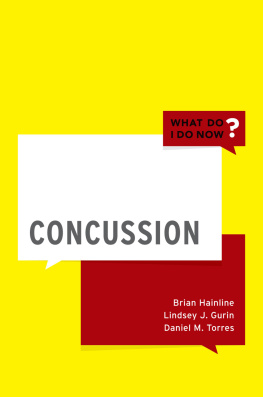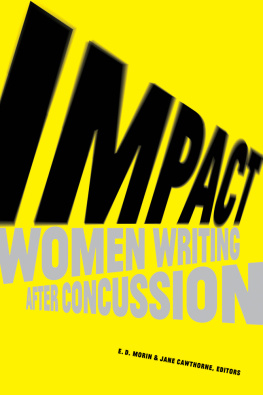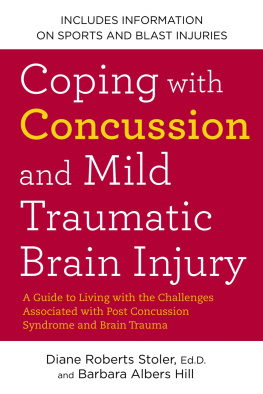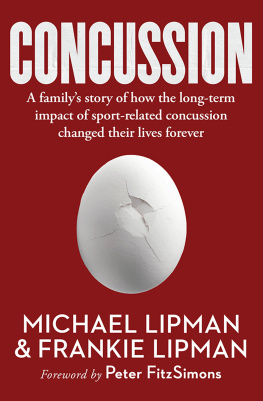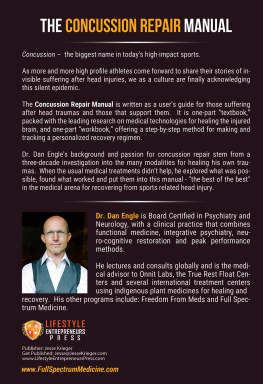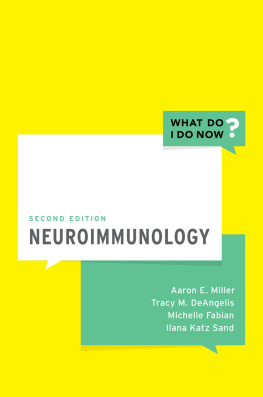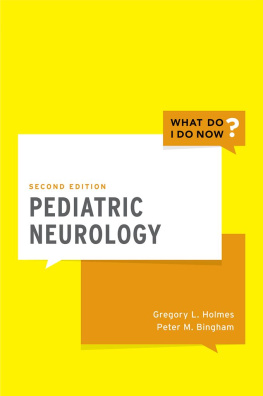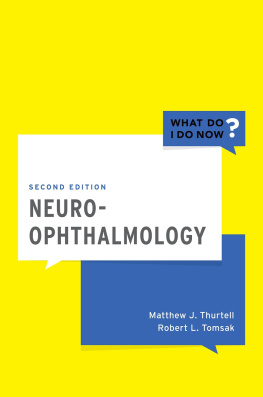Concussion
WHAT DO I DO NOW?
SERIES CO-EDITORS-IN-CHIEF
Lawrence C. Newman, MD
Director of the Headache Division
Professor of Neurology
New York University Langone
New York, New York
Morris Levin, MD
Director of the Headache Center
Professor of Neurology
University of California, San Francisco
San Francisco, California
OTHER VOLUMES IN THE SERIES
Headache and Facial Pain
Epilepsy
Pain
Emergency Neurology
Neuroinfections
Neurogenetics
Neurotology
Pediatric Neurology
Neurocritical Care
Stroke
Peripheral Nerve and Muscle Disease
Cerebrovascular Disease
Movement Disorders
Womens Neurology
Neuroimmunology
Neuro-Ophthalmology

Oxford University Press is a department of the University of Oxford. It furthers the Universitys objective of excellence in research, scholarship, and education by publishing worldwide. Oxford is a registered trade mark of Oxford University Press in the UK and certain other countries.
Published in the United States of America by Oxford University Press
198 Madison Avenue, New York, NY 10016, United States of America.
Oxford University Press 2020
All rights reserved. No part of this publication may be reproduced, stored in a retrieval system, or transmitted, in any form or by any means, without the prior permission in writing of Oxford University Press, or as expressly permitted by law, by license, or under terms agreed with the appropriate reproduction rights organization. Inquiries concerning reproduction outside the scope of the above should be sent to the Rights Department, Oxford University Press, at the address above.
You must not circulate this work in any other form and you must impose this same condition on any acquirer.
CIP data is on file at the Library of Congress
ISBN 9780190937447
eISBN 9780190937461
This material is not intended to be, and should not be considered, a substitute for medical or other professional advice. Treatment for the conditions described in this material is highly dependent on the individual circumstances. And, while this material is designed to offer accurate information with respect to the subject matter covered and to be current as of the time it was written, research and knowledge about medical and health issues is constantly evolving and dose schedules for medications are being revised continually, with new side effects recognized and accounted for regularly. Readers must therefore always check the product information and clinical procedures with the most up-to-date published product information and data sheets provided by the manufacturers and the most recent codes of conduct and safety regulation. The publisher and the authors make no representations or warranties to readers, express or implied, as to the accuracy or completeness of this material. Without limiting the foregoing, the publisher and the authors make no representations or warranties as to the accuracy or efficacy of the drug dosages mentioned in the material. The authors and the publisher do not accept, and expressly disclaim, any responsibility for any liability, loss or risk that may be claimed or incurred as a consequence of the use and/or application of any of the contents of this material.
Contents
I am deeply honored that my neurology colleagues at NYU Langone have asked me to write the foreword for their new book on concussion as part of the series What Do I Do Now? Dr. Brian Hainline, the first chief medical officer at the NCAA, has teamed with two NYU concussion experts, Drs. Lindsey Gurin and Daniel Torres, to create a practical and timely book on how to manage the various problems that arise following concussion. Dr. Hainline, a recognized thought leader in the field, brings a unique background to this endeavor as a former NCAA Division 1 athlete in tennis, as well as a neurologist who has specialized in sports neurology for over three decades. Dr. Hainline has also been on the front line of this area as we gather longitudinal information about the natural history of concussion and its consequences. Dr. Gurin has trained in both neurology and psychiatry, and has a special interest in the cognitive issues that arise after head injury. Dr. Torres is a clinical neurologist who has dedicated his expertise to this area. The book will be welcomed by practitioners in many areas of medicine, as head trauma touches many fields, including neurology, ophthalmology, neurosurgery, sports medicine, orthopedics, and rehabilitation medicineto just name a few.
In 2012, when I arrived to serve as chair of neurology at NYU Langone, the area of concussion was just beginning to be widely recognized as a major cause of morbidity. The problem of repetitive head injury was acknowledged long ago, but the actual consequences had been poorly appreciated by physicians, other practitioners in the field, and the public. A new multidisciplinary service was created at NYU Langone Health to enhance the clinical, educational, and research efforts in this rapidly evolving field. The demand to see patients was extreme, and the need to disseminate information about how to manage them even greater. We initiated frequent case conferences and journal clubs to discuss the challenging problems arising from concussion and other forms of mild traumatic brain injury. This book is, in part, the product of those discussions as well as the vast clinical experience of the authors.
In the preface, the authors outline the purpose of this book as a simple guide that cuts to the chase regarding diagnosis and management of concussion. Using individual case examples, the authors walk through the presentations of concussion, including what to do on the field of play and how to deal with more complicated situations, including cervical spine injury, or how to manage the patient who has evolving neurological signs. Each chapter ends with the key take-home points, and the authors provide a boatload of tables and other helpful forms. The reader is provided with discussions on how to evaluate the patient who worsens at one houror how to approach the patient with continued symptoms. Importantly, the authors provide guidance on how to manage the expectations for recovery. Persistent symptoms are, unfortunately, common for a subset of patients; the reader is guided through specific problems that follow concussion, such as headache, sleep impairment, depression, anxiety, emotional dysregulation, autonomic conditions, vestibular dysfunction, visual impairment, and pituitary dysregulation. The third section of the book is dedicated to other medical and societal considerations associated with the topic of concussion. The authors tackle the issues of hiding concussion, challenging interactions with coaches, retirement from contact sports, and the legal concerns that may follow concussion. In the final sections, contemporary discussions about the long-term consequences of repetitive head injury, such as chronic traumatic encephalopathy, are examined. The book is a quick and enjoyable read, either on an individual issue or as a complete overview of the timely topic of concussion.
The book will appeal to a wide audience, including the many stakeholders of the concussion story, such as athletes, parents, physicians in virtually all areas of medicine, therapists, athletic trainers, coaches, and the lay public. The field of concussion is evolving rapidly; the issues not only are medically complex, but also have great impact on our society and how we view sport in general. Drs. Hainline, Gurin, and Torres have brought all of these issues to the forefront. Their wisdom on manifestations and management will be greatly appreciated by the many who want to know what to do now!

